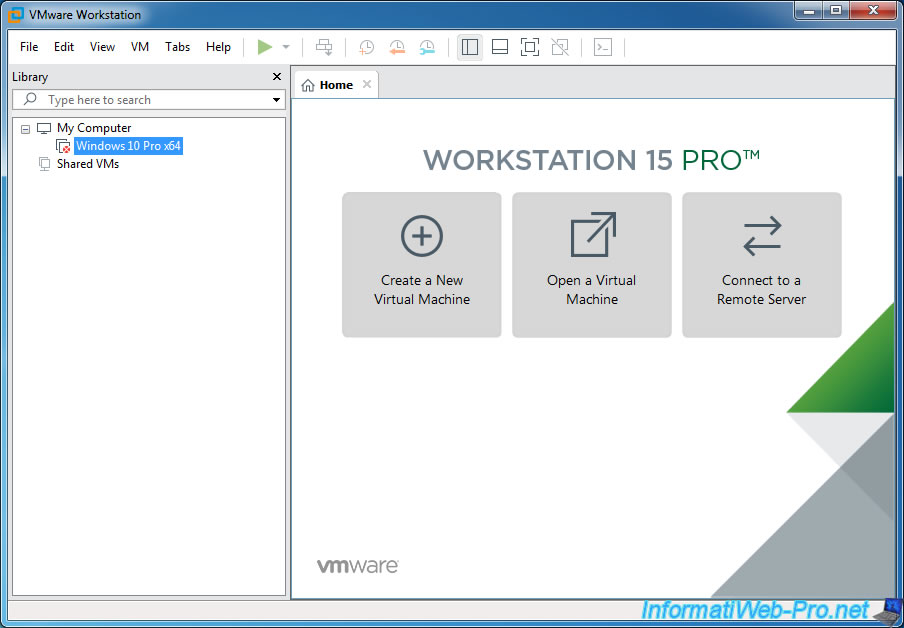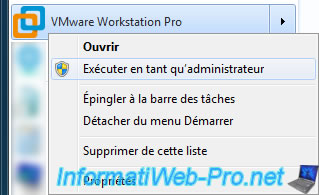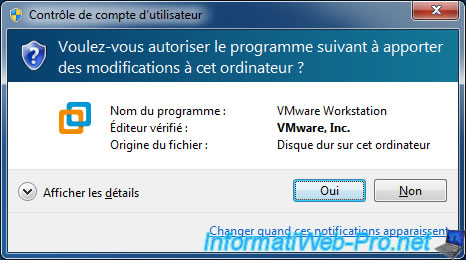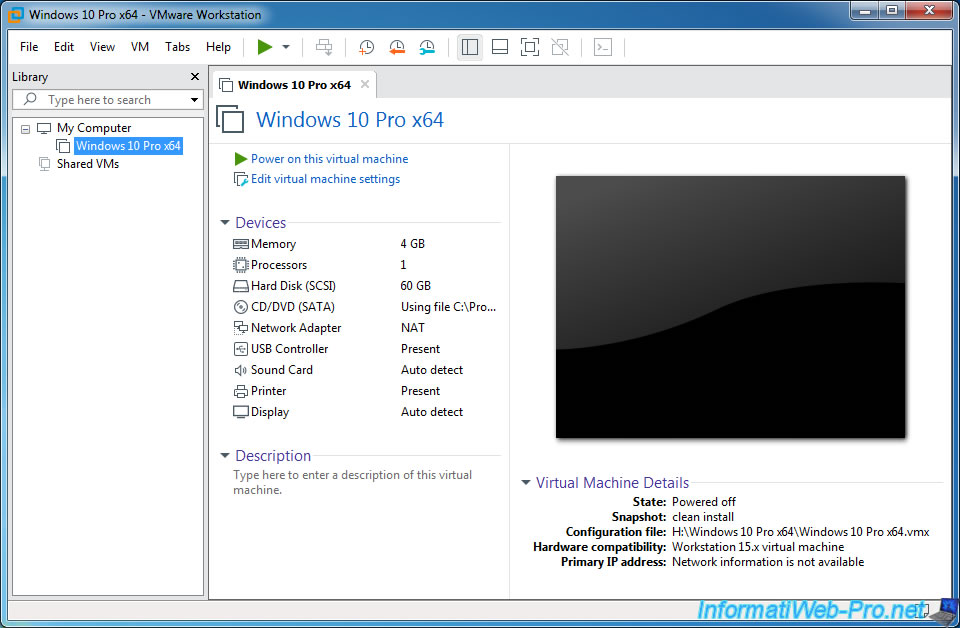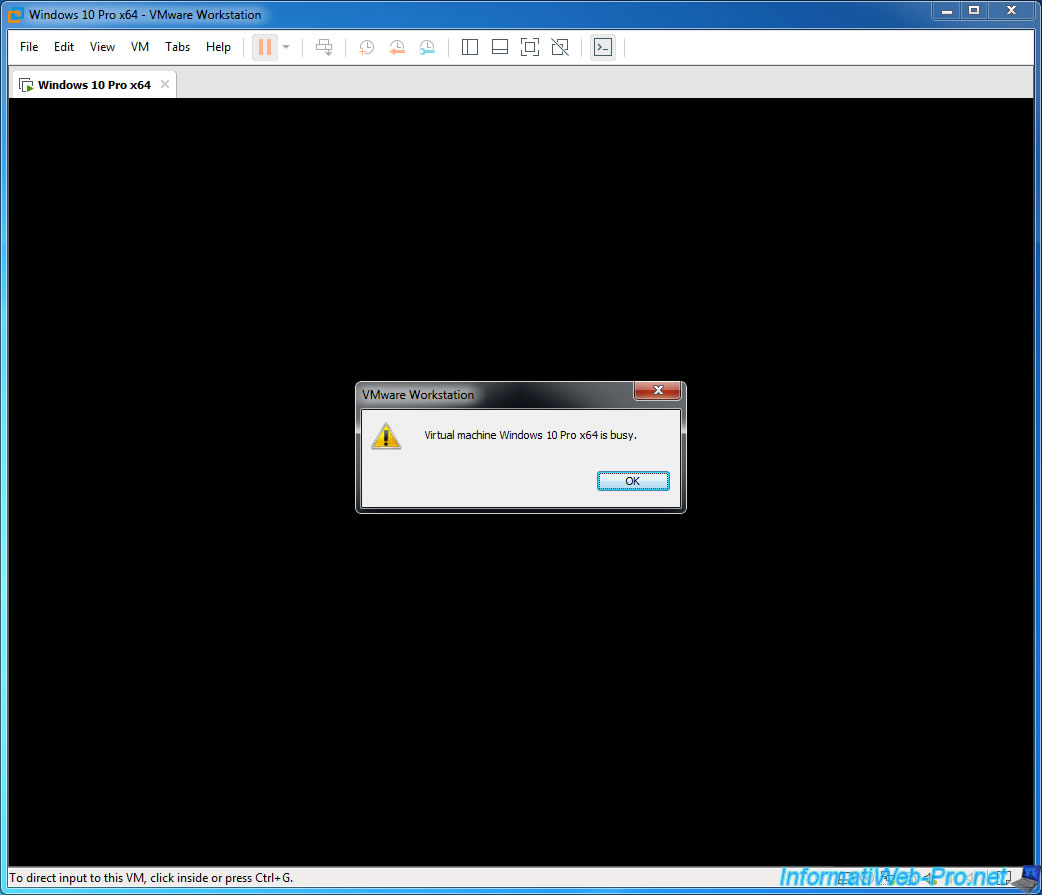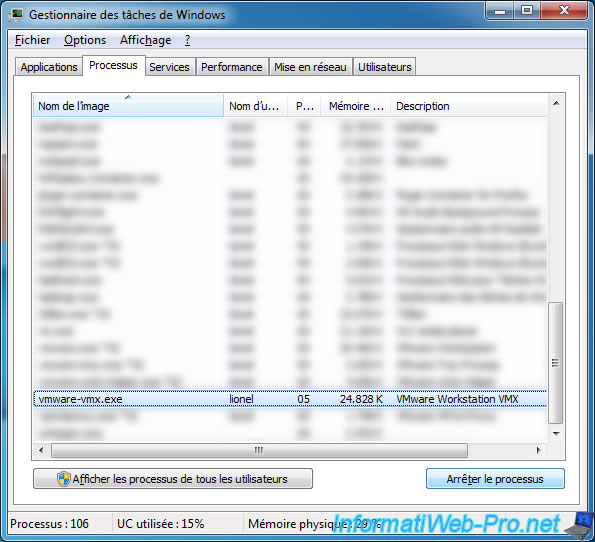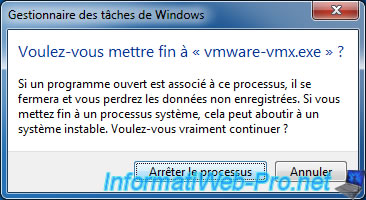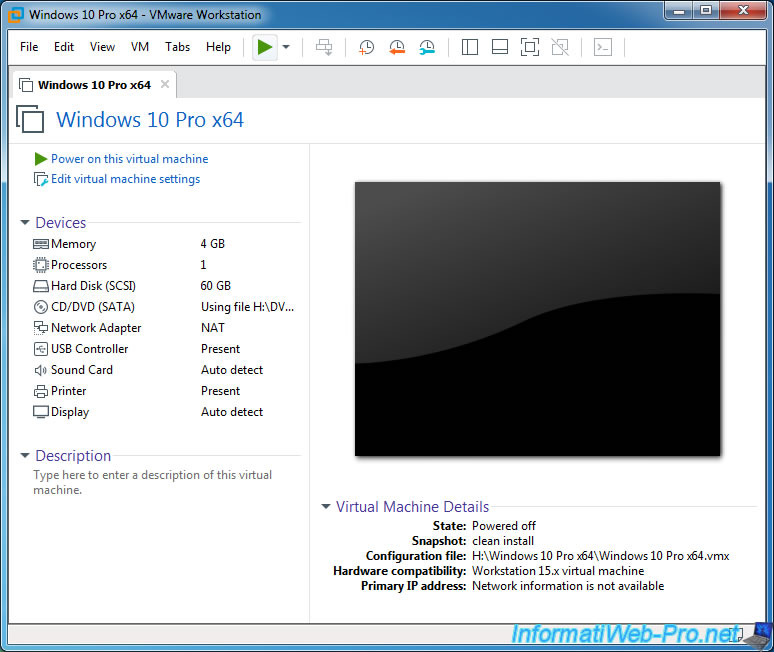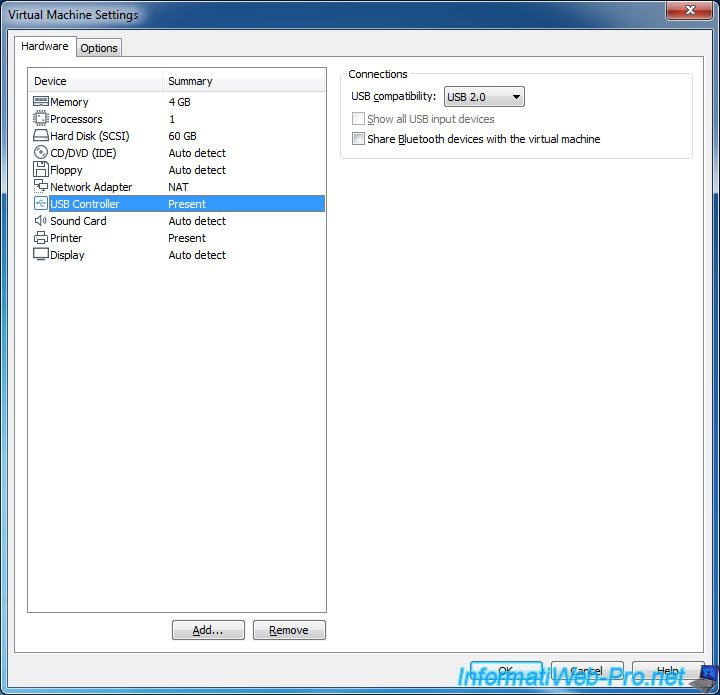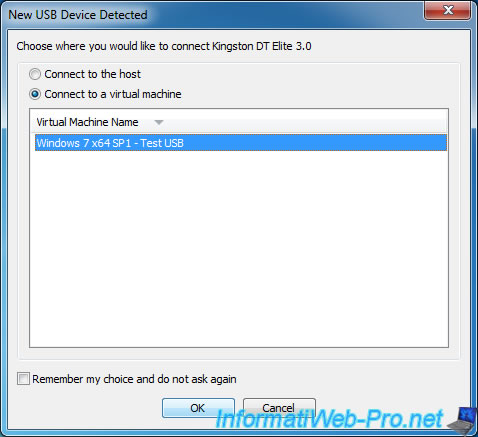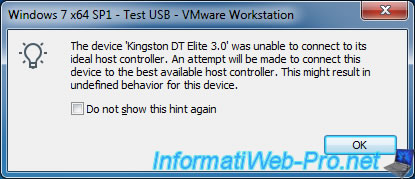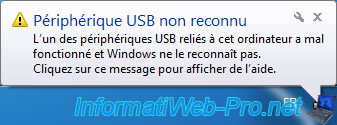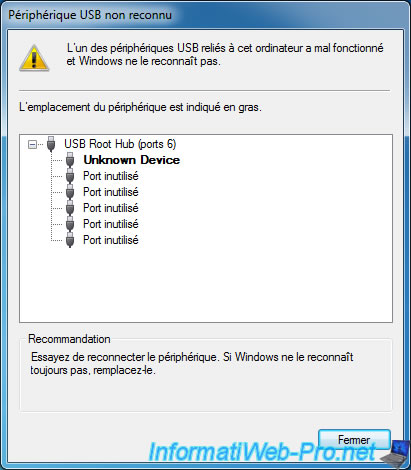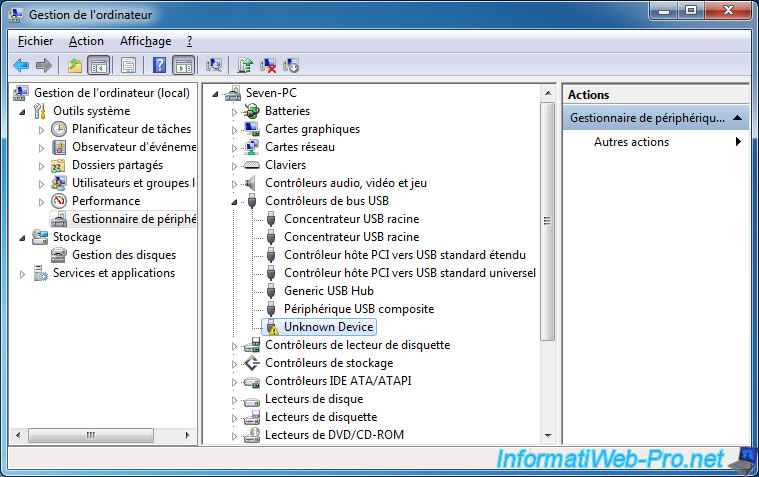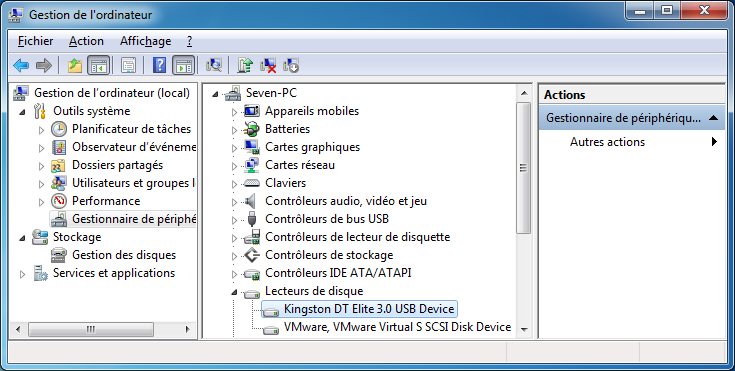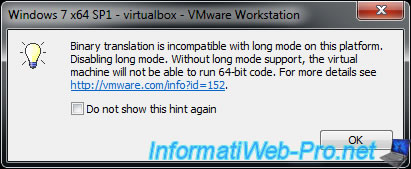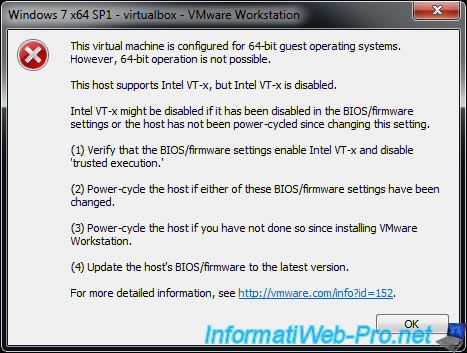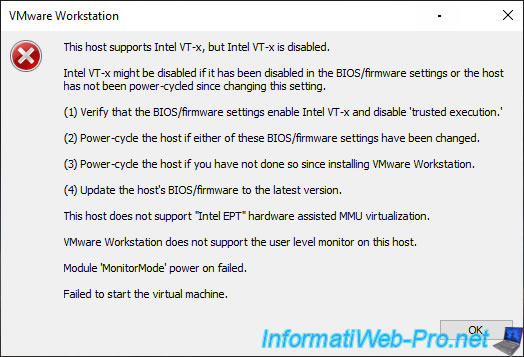Infopackets Reader Paul K. writes:
» Dear Dennis,
We use VMWare Workstation 14 at work as the hypervisor for a number of virtual machines that run on our server. A few days ago we lost power on the server while our database virtual machine (VM) was running. I have since tried to start that virtual machine, but VMWare Workstation keeps popping up with an error message that says ‘This virtual machine might have been moved or copied
(pic). In order to configure certain management and networking features, VMWare Workstation needs to know if this virtual machine was moved or copied. If you don’t know, answer ‘I copied it’. I then have the choice: ‘I moved it’, ‘I copied it’ and ‘Cancel’. I have tried ‘I moved it’ and ‘I copied it’ and VMWare Workstation tells me that ‘Taking ownership of this virtual machine failed‘
(pic). I cannot start the virtual machine. We really need to get to our databases — can you please help? «
My response:
I asked if Paul would like me to connect to his server using my
remote desktop support service in order to have a closer look, and he agreed.
Below I will discuss my findings.
How to Fix: VMWare ‘Taking ownership of this virtual machine failed’ Error
The error message «Taking ownership of this virtual machine failed»
(pic) may occur when you move or copy a virtual machine, in the event if power is lost on the host,
or if the virtual machine is corrupt. To avoid losing power to a virtual machine, the host / server / machine running the hypervisor should have an uninterrupted power supply (UPS) and a RAID with battery backup.
That said, there is a way to fix this problem, which requires manually moving around some files where the virtual machine is stored.
To do so:
- Pause or power off any running virtual machines inside the VMWare Workstation hypervisor.
- Next, launch Task Manager by pressing CTRL + ALT + DEL on the keyboard. Go to the
«Details» tab (for Windows 8 and 10) or the «Processes» tab in Windows 7 and earlier. Next, sort the processes by clicking on the «Details» or «Processes» tab
and look for «vmware-tray.exe» in the list of running tasks. Highlight the «vmware-tray.exe» task by left-clicking the mouse,
then press DEL on the keyboard to end it.
- Go to the folder containing the problematic virtual machine. Next,
look for any «.lck» or «.lock» files AND folders. Select each one by holding down the CTRL key on the keyboard while you left click the desired files / folders. Once all items have been selected,
right click over one of them and select «Cut» from the dialogue menu.
- Next, create a «Temp» folder inside the directory, then right click over top of Temp
and select «Paste«. The items you highlighted in Step #3 should be moved to the Temp folder.
- Start VMWare Workstation again. Click Start, then type in «VMWare Workstation»; wait for «VMWare Workstation Pro» or such to appear in the list, then click it. This will start the VMWare Workstation hypervisor. If it does not launch full screen, go to
the task bar (by the clock) and locate the VMWare Workstation icon, then double click it to open it full screen.
Locate your problematic virtual machine, then start it.
At this point, the virtual machine should now start. If it does not then you
are welcome to contact me for additional support, described next.
Additional 1-on-1 Support, From Dennis
If you are still stuck with the VMWare Workstation error «Taking ownership of this virtual machine failed«, or if the virtual machine still won’t start despite applying the instructions described in this article, I can help using my
remote desktop support service. Simply
contact me, briefly describing the issue and I will get back to you as soon as possible.
Got a Computer Question or Problem? Ask Dennis!
I need more
computer questions. If you have a computer question — or even a computer
problem that needs fixing — please
email me with your question so that I can write more articles like this one.
I can’t promise I’ll respond to all the messages I receive (depending on the
volume), but I’ll do my best.
About the author: Dennis Faas is the owner and operator of
Infopackets.com. With over 30 years of computing experience, Dennis’ areas of
expertise are a broad range and include PC hardware, Microsoft Windows, Linux,
network administration, and virtualization. Dennis holds a Bachelors degree in
Computer Science (1999) and has authored 6 books on the topics of MS Windows and
PC Security. If you like the advice you received on this page, please up-vote /
Like this page and share it with friends. For technical support inquiries,
Dennis can be reached via Live chat online this site using the Zopim Chat
service (currently located at the bottom left of the screen); optionally, you
can contact Dennis through the website
contact form.
VMware Workstation is a professional virtualization solution that allows you to do a lot of things and is able to manage many virtual machines at the same time (if the resources of the host PC allow it).
However, in rare cases (and especially when you edit manually some settings in the vmx files), VMware Workstation can become unstable and arrive in a state where you will not be able to access or close some virtual machines.
Again, this is very rare, but here is how to solve ou avoid these problems.
- Take ownership error
- Freeze of a virtual machine
- Conflict detected : Panda USB vaccine
- Conflict detected : Disk Management
- The device was unable to connect to its ideal host controller
- This VMware USB Device can perform faster
- This host supports Intel VT-x, but VT-x is disabled
1. Take ownership error
At some moments, you may not have access to a virtual machine (even if it’s down and not password protected).
When you want to access it from VMware Workstation, a «This virtual machine appears to be in use» warning is displayed.
VMware Workstation offers you to obtain the rights on it by clicking on : Take Ownership.
Plain Text
If this virtual machine is not in use, press the "Take Ownership" button to obtain ownership of it. Otherwise, press the "Cancel" button to avoid damaging it.
This warning can occur in 2 cases :
- you have opened 2 windows of VMware Workstation and you are trying to open the same virtual machine from the 2 windows. In this case, click : Cancel.
- VMware Workstation has become unstable or a bug is temporarily blocking you from accessing it. In this case, click : Take Ownership.
Most of the time, it will fail and this message will appear :
Plain Text
Could not open virtual machine ... .vmx Taking ownership of this virtual machine failed. The virtual machine is in use by an application on your host computer. Configuration file: ... .vmx
Click Cancel.
Note that in older versions of VMware Workstation, the icon displayed was an error icon and the «Remove» button did not exist.
With these older versions, you had to click OK.
Since VMware Workstation can’t open this virtual machine, a red icon appears on it.
To solve this problem, close all open VMware Workstation windows and open VMware Workstation again, but as an administrator.
Click Yes.
Now, you will have access to your virtual machine.
From now, you will be able to access it again normally (without having to restart VMware Workstation every time as administrator).
2. Freeze of a virtual machine
When you run too many virtual machines at the same time or you have mismanaged the amount of RAM allocated to them, your virtual machines may fail.
If it’s not too late, try pausing them to prevent the guest OS from being damaged. Then, restore the virtual machines one by one by stopping them correctly before «booting» the next virtual machine.
If it’s too late, you may not be able to force the virtual machine to shutdown from VMware Workstation.
Indeed, in this case, we wanted to shut down Windows properly by sending the Windows shutdown ACPI signal from VMware Workstation (via the «Shut Down Guest» option).
The problem is that the virtual machine never stopped, and because the virtual machine was shut down, no more options were available for this virtual machine.
Even when you want to close VMware Workstation to force the virtual machine to shut down, it will not work because VMware Workstation will display this warning : Virtual machine is busy.
In this case, you will only have 2 possibilities :
- shut down your computer : except that shutting down your computer will take a long time, because of this problem. Even if in the end after a few minutes, even 10 minutes, the host PC will finally turn off properly.
- stop other virtual machines that you can still shut down properly, then kill the «vmware-vmx.exe» process that allows the virtual machine to run on the host PC.
The only problem is that you can’t know which instance of the «vmware-vmx.exe» process corresponds to which virtual machine.
For security, you will have to shut down all possible virtual machines before killing this process or processes. Otherwise, you risk cutting off a virtual machine that was still running correctly.
Confirm the action.
Like magic, the virtual machine will be considered shut down by VMware Workstation.
Nevertheless, don’t forget that the sudden shutdown of the «vmware-vmx.exe» process only allows you to recover your hand on the management of the host PC.
Indeed, by killing the «vmware-vmx.exe» process, the host PC will become unstable because of the information left in its RAM.
This may result in a slower shutdown of your host PC when you shut down Windows this time.
Once the host PC is shutdown and then power on again (and not with an automatic restart from Windows), the RAM will be correct again.
This solution therefore only allows you to save what you were doing, rather than losing important changes because of a virtual machine that would have become unstable.
3. Conflict detected : Panda USB vaccine
On our InformatiWeb.net website, we talked about the Panda USB Vaccine program that automatically vaccinate USB keys that you connect to your computer to prevent a virus on a USB key infect your physical PC.
The problem is that from the moment you use VMware Workstation, you will not be able to use the automatic vaccination of USB keys with Panda USB Vaccine.
When at least 1 virtual machine is running with VMware Workstation, if you plug an USB key on your physical PC, VMware Workstation and the currently powered virtual machine will be freezers.
Which is very problematic.
To avoid this conflict, we recommend that you no longer use Panda USB Vaccine on your PC where VMware Workstation is installed.
Update : this problem no longer occurs on Windows 10 v2004.
4. Conflict detected : Disk Management
As you probably know, on Windows, you can manage disks (and their partitions) by right-clicking on Computer (or This PC), then clicking on : Disk Management.
The problem is that when virtual machines run on VMware Workstation on your PC, there is a good chance that your PC (including VMware Workstation and the «Computer Management» console) will start blocking (freezing).
Update : this problem no longer occurs on Windows 10 v2004.
It’s pretty annoying, but be aware that this bug only occurs if virtual machines are running when you want to manage physical PC disks.
If no virtual machine is currently running, disk management will be possible without any problem.
PS : if you konw other conflicts that occur each time in the same way, don’t hesitate to point them out in comments for us to add them in this tutorial.
5. The device was unable to connect to its ideal host controller
Depending on the guest OS you are virtualizing, VMware Workstation selects the most suitable version for the USB controller of your virtual machine.
However, this can be problematic in some cases.
For example : you can’t plug an USB 3.0 key into an USB 3.0 port on the host PC and pass it to a virtual machine using a USB 2.0 or lower controller.
If VMware Workstation displays the «New USB Device Detected» window, select the virtual machine to which you wish to connect the USB key (or any other USB support).
As mentioned above, you will not be able to plug an USB 3 key into an USB 3 port on the host PC and pass it to a virtual machine using version 2.0 or lower of the USB controller.
In this case, an error will be displayed :
Plain Text
The device '[Name of the USB 3.0 key]' was unable to connect to its ideal host controller. An attempt will be made to connect this device to the best available host controller. This might result in undefined behavior for this device.
Click OK.
Due to the previous error, an error will also be displayed in the guest OS :
Plain Text
USB Device Not Recognized One of the USB devices attached to this computer has malfunctioned, and Windows does not recognize it. For assistance in solving this problem, click this message.
If you click on this message, you will see a window appear with an «USB Root Hub» and an «Unknown Device» (which corresponds to your USB key).
In the device manager, you will see the same problem.
To solve this problem, simply plug your USB key into a USB 2.0 port on your host PC.
Or change the version of the virtual machine’s USB controller to USB 3.0 if you want to connect it to a USB 3.0 port on your host PC.
6. This VMware USB Device can perform faster
If you plug an USB 3.0 key or any other USB storage medium (such as an external hard drive) to an USB 2.0 port on your host PC, this message will be displayed on the host PC where VMware Workstation is installed.
Plain Text
This device can perform faster. This VMware USB Device can perform faster if you connect it to a Hi-Speed USB 3.0 port.
When you pass this USB 3.0 key to your virtual machine, a similar message will appear :
Plain Text
This USB Mass Storage Device can transfer information faster ...
However, the USB key will be accessible from the guest OS.
As you can check in the device manager.
7. This host supports Intel VT-x, but VT-x is disabled
When you launch one of your virtual machines, one of these messages appears :
Plain Text
Binary translation is incompatible with long mode on this platform. Disabling long mode. Without long mode support, the virtual machine will not able to run 64-bit code. For more details see https://vmware.com/info?id=152.
Plain Text
This virtual machine is configured for 64-bit guest operating systems. However, 64-bit operation is not possible. This host supports Intel VT-x, but VT-x is disabled. Intel VT-x might be disabled if it has been disabled in the BIOS/firmware settings or the host has not been power-cycled since changing this setting. (1) Verify that the BIOS/firmware settings enable Intel VT-x and disable 'trusted execution.' (2) Power-cycle the host if either of these BIOS/firmware settings have been changed. (3) Power-cycle the host if you have not done so since installing VMware Workstation. (4) Update the host's BIOS/firmware to the latest version. For more detailed information, see https://vmware.com/info?id=152.
Depending on your version of VMware Workstation Pro, the error message may be a bit longer and include this :
Plain Text
VMware Workstation does not support the user level monitor on this host. Module 'MonitorMode' power on failed. Failed to start the virtual machine.
These errors occur when processor virtualization is not supported by your processor (CPU), motherboard BIOS, or not enabled by default in your motherboard BIOS.
If your processor supports processor virtualization (Intel VT-x or AMD-V), you just need to enable it in your motherboard BIOS.
Important : if you have just installed VMware Workstation and the «This host supports Intel VT-x, but VT-x is disabled» error message appears, restart your computer at least once.
If this error message persists, then processor virtualization is not enabled and/or supported by the BIOS of your motherboard.
VMware Workstation Pro is the industry standard for running multiple operating systems as virtual machines (VMs) on a single Linux or Windows PC. IT professionals, developers, and businesses who build, test, or demo software for any device, platform, or cloud rely on Workstation Pro. VMware Workstation Pro allows you to run multiple virtual machines, OCI containers, and Kubernetes clusters at once on the same Windows or Linux PC. Create fully featured and securely isolated Linux and Windows VMs and other desktop servers, and cloud environments, complete with configurable virtual networking and network condition simulation, for use in code development, solution architecting, application testing, product demonstrations, and more. Here are some similar VM errors, the virtual machine has terminated unexpectedly during startup with exit code 1 (1×0), and Windows failed to start, a recent hardware or software change might be the cause.
VMware Workstation runs on standard x86-based hardware with 64-bit Intel and AMD processors, and on 64-bit Windows or Linux host operating systems. For more detail, see our System Requirements documentation.Root cause: You are trying to open another VM console while there is actually one running and open or there are lockfiles or lockdirs. To fix this issue, kindly follow the steps discussed below.
Method 1: You already have an open console and you are trying to open a new one:
Even you try to take ownership, it will fail with the following error below.

Just search for an open VM session from the taskbar. This will open the Virtual Machine window

Method 2: The lockfiles or lockdirs: If the above method does not work for you, please try the following method as suggested below. See these guides on some related contents: How to fix VirtualBox Displaying only 32 bits Option, and how to enable Hyper-V on a VMware Workstation.
- Exit (close) the VMware Workstation
- Find and delete all files with the extension .lck or .lock in the directory of the VM that is causing this trouble
- Try to start the VM again.
I hope you found this blog post helpful. If you have any questions, please let me know in the comment session.

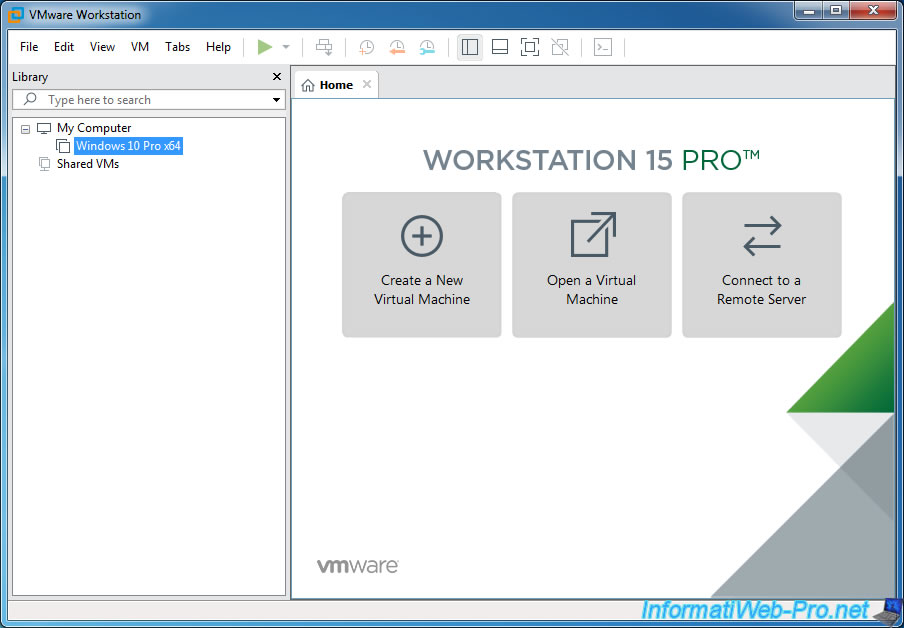
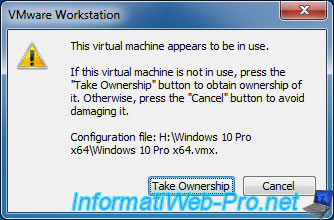
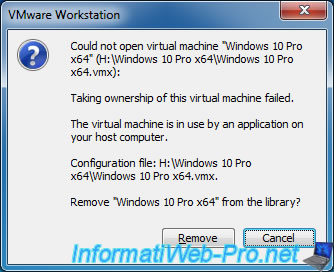
.jpg)
